- Blog
- Gender Differences in Advertising Between Men and Women: Do Gendered Advertisements Help or Hurt?
Gender Differences in Advertising Between Men and Women: Do Gendered Advertisements Help or Hurt?
Table of Contents
The advertising world is rapidly adapting to shifting expectations around gender, identity, and representation.
As consumers become more aware of bias and stereotypes, gender equality now plays a major role in how people interpret marketing messages and decide which brands to support.
While marketers once built campaigns exclusively around “male” or “female” audiences, today’s leading brands are moving beyond binary targeting and toward more inclusive, interest-based messaging.
In this article, we’ll cover:
- What gender marketing is
- Whether gender-based advertising still drives sales
- Some gender based marketing examples
- How to personalize your messages without relying on stereotypes
Let’s dive in.
What is gender marketing?
Gender marketing is a strategy that separates audiences into “men” and “women” and builds messaging based on assumptions about how each gender thinks, behaves, or shops. These assumptions often manifest in product design, packaging, color choices, or brand voice, and influence marketing efforts significantly.
Common examples include:
- pink products aimed at female consumers and darker, “masculine” colors targeted at male consumers
- “for him” vs. “for her” product variations
- skincare lines divided strictly by gender rather than by skin concerns
These patterns have been prevalent for decades. Older advertisements strongly reinforced stereotypical roles men as decision-makers and women as homemakers.
Although society has evolved, many marketing practices still reflect these outdated assumptions about male and female consumers.
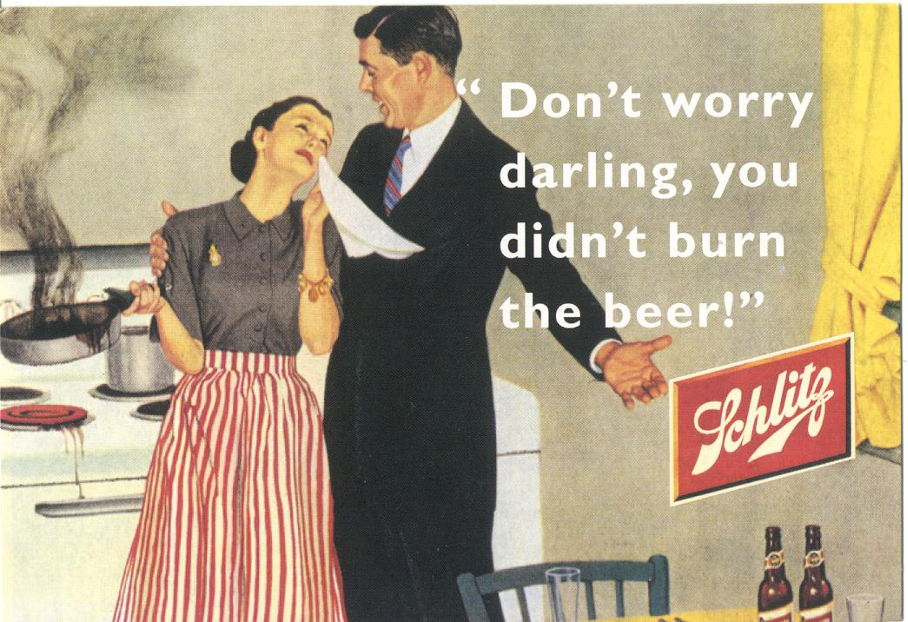
Does gender-based marketing help your sales?
Short answer: not anymore.
Relying on outdated gender clichés and traditional gender stereotypes rarely resonates with modern consumers and in many cases, it can actively harm your brand.
While some marketers still believe that tailoring products or messages strictly to “men” or “women” boosts conversion rates, this assumption no longer holds up.
There are two major reasons why gendered advertising is losing effectiveness:
1. Traditional gender roles are disappearing
Decades ago, households followed predictable roles: men earned the income and women managed the home. Today, both partners often work, share responsibilities, and make purchase decisions together.
This shift in gender demographics means that messages built on rigid stereotypes feel irrelevant and disconnected from real life.
2. Younger consumers reject the gender binary
Research shows that 50% of millennials view gender as a spectrum, not a fixed category. Gen Z is even more fluid in how they express identity. For these consumers, gendered marketing isn’t just outdated—it can feel exclusionary or offensive.
This shift significantly impacts:
- how people respond to ads
- what brands they trust
- which products they consider “for them”
What this means for your ad strategy
These cultural changes require marketers to update their playbook. Instead of relying on broad gender assumptions, brands need to segment based on interests, behaviors, lifestyle, and intent attributes that actually influence purchase decisions.
In the next sections, we’ll look at examples of brands succeeding with gender-neutral approaches and actionable personalization methods you can implement right away.
How can marketers stop focusing on gender roles?
In the past, it seemed natural to create targeted ads based on gender. Marketers believed that separating male and female audiences would boost engagement and conversion rates. However, as consumer expectations evolve, it’s clear that focusing on gender is no longer the most effective strategy.
So, how can you continue targeting specific consumer segments without relying on outdated gender roles? The key lies in segmenting by other variables that better reflect today’s diverse audience.
Shift from binary gender to interests and behaviors
Rather than labeling products as “for him” or “for her,” consider grouping them by:
- Age
- Product type (e.g., toys, gadgets, fashion)
- Brand
- Lifestyle preferences (e.g., eco-friendly, tech-savvy, minimalist)
Brands like Toys “R” Us have already started categorizing products by age, theme, or interest, rather than gender.
This approach allows them to create more meaningful consumer segments and build a better shopping experience.

This approach allows them to create more meaningful consumer segments and build a better shopping experience.
Let’s have a look at a few other brands that embrace gender-neutral marketing.
Brands that embrace gender neutrality
Several brands have successfully moved away from gendered marketing and are now focusing on inclusivity and broader appeal.
These brands are seeing not only better consumer engagement but also expanding their reach to new customer segments.
Historically associated with male consumers, Johnnie Walker has embraced a more inclusive marketing approach, featuring women in their campaigns and promoting whiskey as a drink for all.
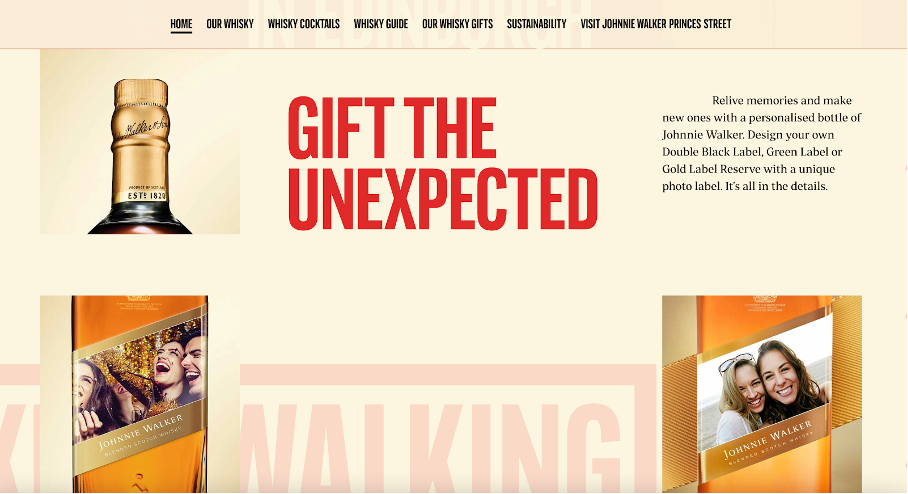
Once exclusively a male-dominated brand, Harley-Davidson now recognizes and celebrates women motorcycle enthusiasts. Their website and marketing materials reflect this shift, showcasing both men and women in their content.
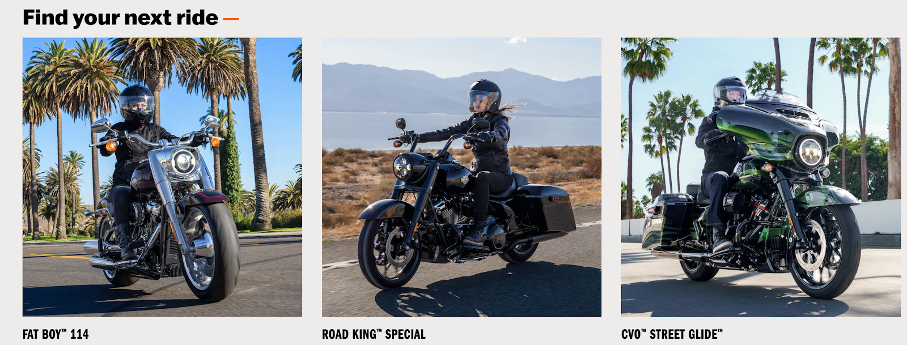
Calvin Klein launched “CK Everyone”, a gender-neutral fragrance, along with an inclusive campaign titled “I Love Everyone of Me,” featuring a diverse range of genders.
The brand’s commitment to breaking down gender barriers resonates with today’s consumers.

Lego eliminated gender-specific labeling for toys, opting instead to categorize products by age and interests.
This move has allowed Lego to create a more personalized shopping experience for all customers, regardless of gender.

How you can personalize your messages without relying on gender stereotypes
One of the most effective ways to personalize your website without relying on gender is through conversational popups. These popups engage customers directly by asking about their preferences, interests, or needs.
For example, you might ask a visitor:
- “What type of wine do you prefer?”
- “Which skincare concerns are you looking to address?”
Rather than assuming their gender, these questions focus on the visitor’s actual interests and offer incentives (like discounts) in return for valuable insights.
This way, you can segment users based on their responses, building targeted campaigns that feel personal and relevant.
Here’s a sample from OptiMonk’s conversational popup:
This form asks customers about their favorite wine region, later offering a coupon code in exchange for their email address.
Not only does this gather useful information, but it allows you to tailor follow-up communications based on their preferences.
Conversational popups offer great value by allowing you to gather user data, which can then be used to segment your audience and deliver personalized marketing messages. For example, you can build email lists based on user responses and send targeted email content to each segment.
Many ecommerce stores are taking this a step further by using quizzes to collect customer information.
Quizzes are effective because they promise to uncover something personal about the customer after they answer a series of questions.
For instance, Sephora uses a quiz to help users find the best solutions for their specific hair care needs.
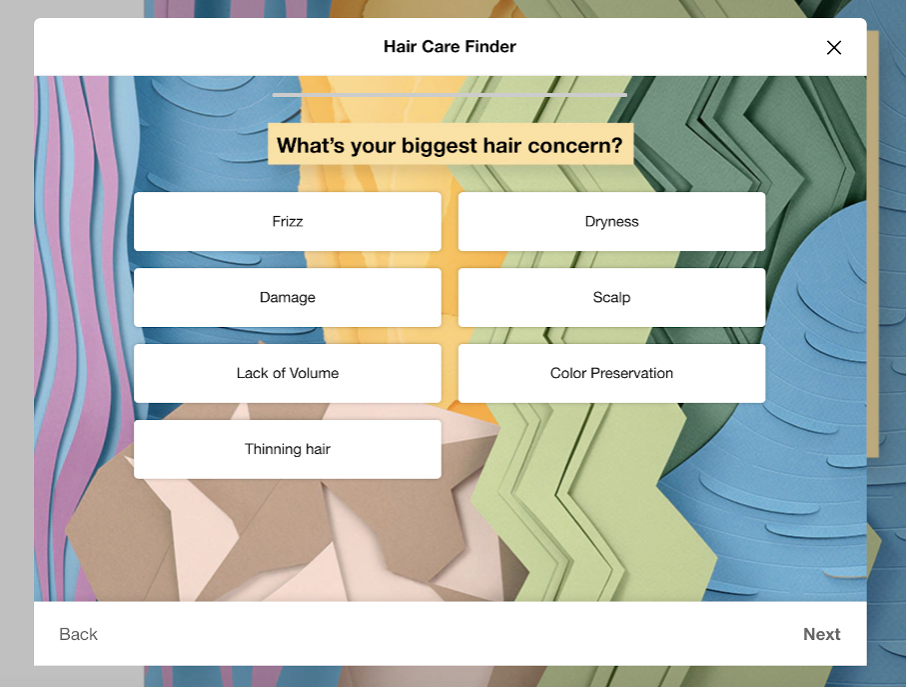
Recommended reading: 7 Successful Quiz Funnel Examples to Inspire You
2. Deliver relevant product recommendations based on real interests
Once you know more about your customers’ preferences, you can recommend products that genuinely fit their needs, no gender required.
Here are some personalization strategies that focus on interests and behaviors:
1. Popular products
People of all genders often want the “hottest” or most popular items. Recommending top-sellers appeals to broad audiences without relying on gender assumptions.
2. Product categories
If a visitor is browsing through a specific category, recommend more products from the same category. For instance, if a customer is viewing a laptop, suggest related accessories like laptop sleeves or stands.
3. Complementary items
Cross-selling is an excellent way to increase sales while being relevant. For example, if someone is looking at coffee machines, you could recommend coffee beans or mugs.
4. Segmentation-based recommendations
If you’ve gathered insights through a conversational popup or quiz (as we discussed earlier), you can tailor recommendations based on their answers.
This ensures you’re suggesting products that align with their specific interests, regardless of gender.
Here are some examples from OptiMonk’s product recommendation templates:
3. Use different cart abandonment flows for subscribers vs. non-subscribers
Which stage of the customer journey a visitor is at should make a far larger difference to your messaging than what gender they identify as.
The approach you take to visitors who are familiar with your brand and products should be very different from the one you use for new visitors who’ve just discovered you.
You should have two distinct cart abandonment flows (the messaging you send to users who’ve added items to their cart, but are about to close your website without completing their purchase) to target these two segments.
You can assume that site visitors who’ve already signed up for your email list are familiar with your brand. Therefore, they’re more likely to make a purchase than new visitors, which means you can send them both an on-site popup message and an email following up on their abandoned cart.
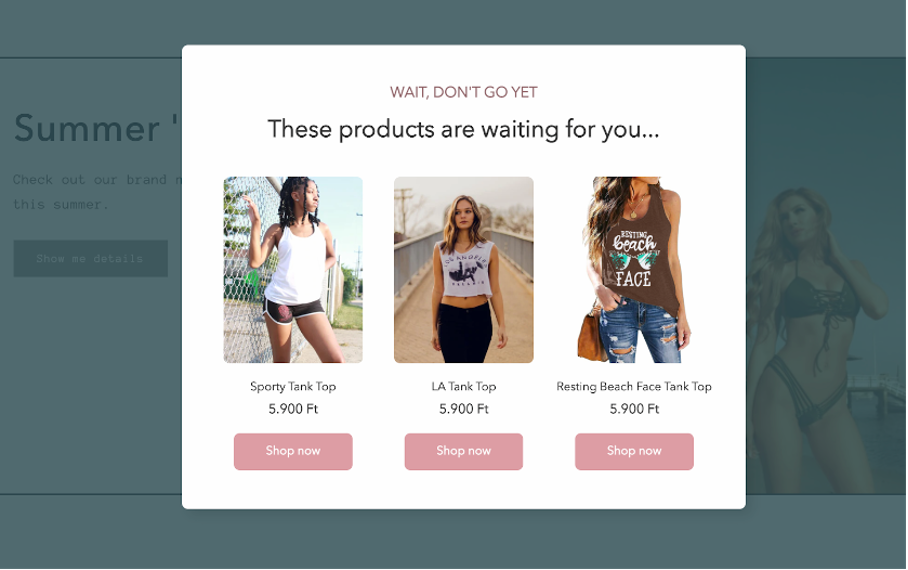
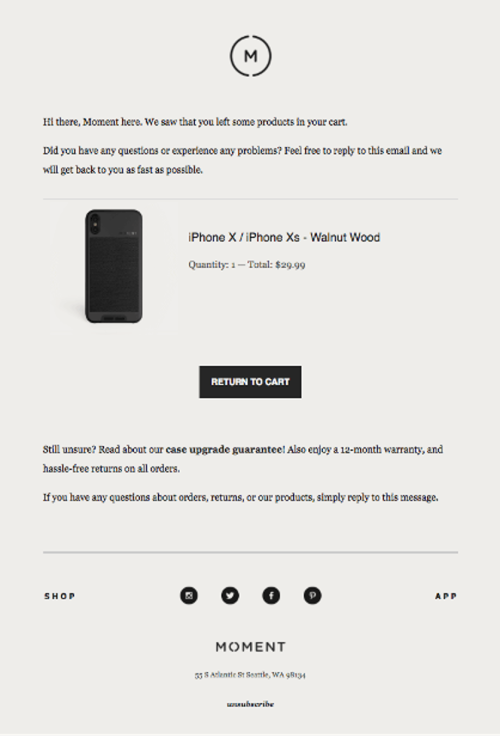
Users who haven’t subscribed to your email list might need a bigger push to make a purchase. That’s why we recommend capturing their attention before they leave with a significant (but time-limited) discount offer.
Here’s what a cart abandonment popup for new subscribers could look like:
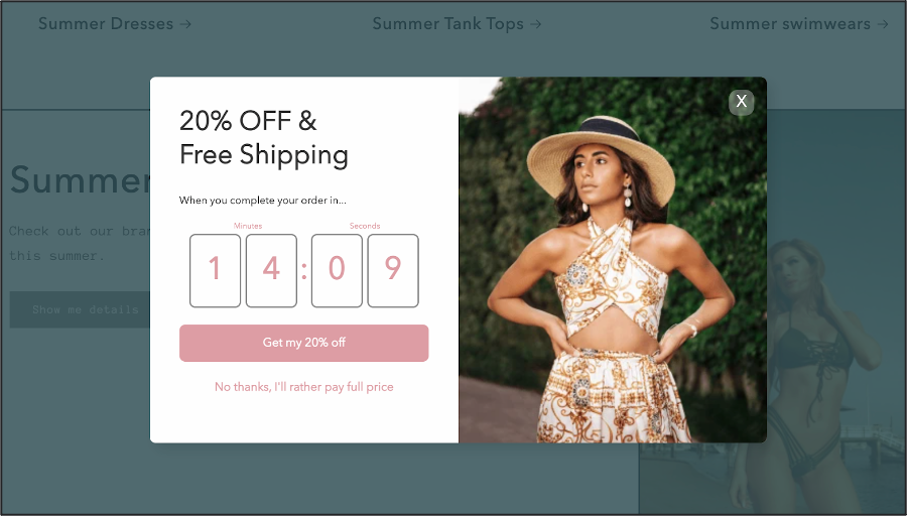
The fact that they only have 15 minutes to use their big discount creates a powerful sense of urgency, encouraging those new visitors to buy now rather than later.
You can collect emails with cart abandonment popups by making an email address required in order to get the coupon code. Even if they don’t end up using the coupon code, you’ve still added a new subscriber to your email list. That counts as a win!
Here are a few of our most popular cart abandonment popups:
4. Tailor the customer experience for returning visitors
If you’ve been collecting data about your visitors, you should put it to good use when someone returns to your site.
Here’s an example of a message regular shoppers would love to see, notifying them about new items you’ve added to your inventory:

Another way to make your customer experience more convenient for your returning visitors is by starting off their session with a reminder of what they were looking at last time.
Using OptiMonk, you can display the products they’ve recently been browsing, like in the example below. This can help users find products that they’ve been considering for some time.
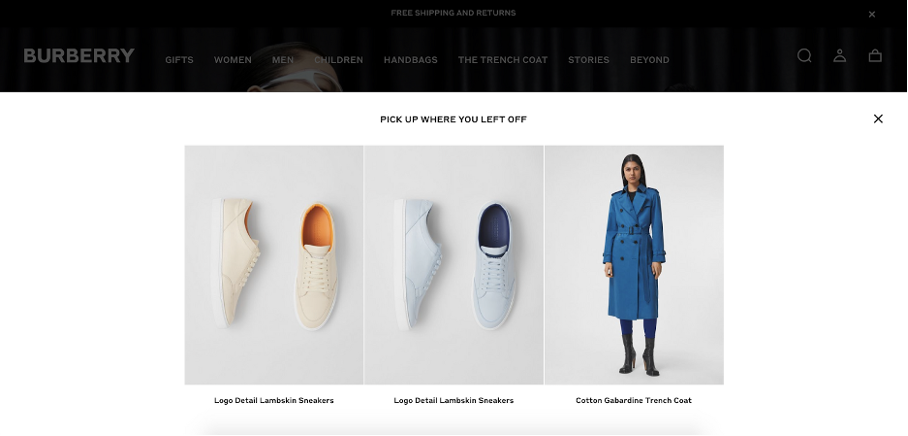
5. Display shipping info based on visitor location
A particularly useful method for personalizing your website is showing shipping information based on where a user is browsing from.
Unexpected shipping costs are one of the biggest reasons online shoppers don’t complete purchases, so you want to ensure that everyone knows what it will cost to ship to their country.
You can use a sticky bar to notify your customers about your shipping policies, like below:

Using OptiMonk’s targeting features, you can set up different messages about shipping based on the country someone is browsing from.
So the banner above might read “Free Shipping on Canadian orders over $40” for shoppers whose I.P. address is located in Canada.
You could also consider providing an even more interactive experience by using one of OptiMonk’s Dynamic Free Shipping Bars, which update as items are added to a visitor’s cart to show how much more they need to spend in order to reach the free shipping threshold.
The sequence looks like this:



Recommended reading: How to Boost Your Shopify Sales with Free Shipping Bars
6. Personalize based on traffic source
Lastly, consider where your visitors are coming from. Personalizing your messaging based on the traffic source can make your communications more relevant.
For instance, if a visitor arrives from a Facebook ad, the popup or message they see might differ from someone who comes via an organic Google search.
This helps create a more tailored experience that fits the visitor’s expectations.
Here’s an example of a Facebook-specific popup:

FAQ
What is gender-neutral marketing?
Gender-neutral marketing moves away from targeting consumers based solely on gender. Instead, it focuses on personalizing messages based on interests, behaviors, and lifestyle choices. Brands no longer limit their appeal to just “men” or “women,” but rather create inclusive campaigns that resonate with a broader audience.
How do I collect data for personalized, non-gendered campaigns?
You can gather non-gendered data through:
- Website behavior: Track actions like page views, product clicks, and cart abandonment to understand interests.
- Quizzes and surveys: Use conversational popups or quiz funnels to collect insights about preferences, needs, and behaviors.
- Customer segmentation tools: Utilize platforms that allow you to segment based on purchase history, preferences, and interactions, rather than demographic factors like gender.
How can gender inclusive marketing improve brand reputation?
Adopting gender-neutral marketing can strengthen your brand’s reputation by positioning it as modern, inclusive, and aligned with current cultural shifts. This approach helps attract a wider customer base, including younger generations who value authenticity and inclusivity in the brands they support.
What are some gender-based marketing examples, and why should brands move away from them?
Gender-based marketing examples often involve creating distinct products or advertisements for men and women. Some common examples include:
- Clothing ads that feature pink items for women and blue items for men.
- Toys marketed as “for boys” (e.g., cars, action figures) and “for girls” (e.g., dolls, cooking sets).
- Product packaging where women’s products use lighter, softer colors, and men’s products use darker, more neutral tones.
These practices are increasingly seen as outdated and limiting. Consumers today are more likely to value inclusivity and personalization over stereotypical gender-based messages, which is why brands are shifting towards more gender-neutral and interest-based marketing strategies.
Wrapping up
The age of advertising based on gender roles is basically over. Men, women, and all other genders tend to appreciate messaging that responds to their actual interests.
So whether you’re selling children’s toys or motorcycles, it’s time to update your advertising approach and drop outdated stereotypes about men being “breadwinners” or ideas like the “feminine touch.” Not only will you avoid controversy, but your messaging will be more relevant, too.
Have you already started gender-neutral advertising? Do you have any examples of gender-based advertising fails?
Migration has never been easier
We made switching a no-brainer with our free, white-glove onboarding service so you can get started in the blink of an eye.
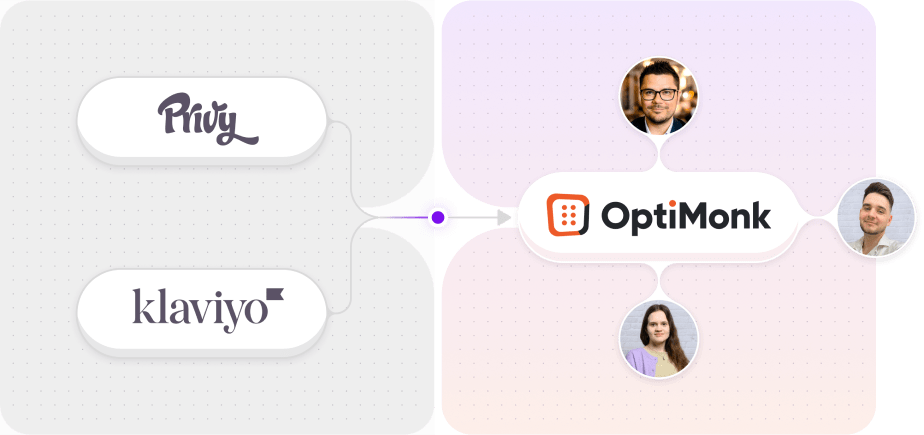
What should you do next?
Thanks for reading till the end. Here are 4 ways we can help you grow your business:
Boost conversions with proven use cases
Explore our Use Case Library, filled with actionable personalization examples and step-by-step guides to unlock your website's full potential. Check out Use Case Library
Create a free OptiMonk account
Create a free OptiMonk account and easily get started with popups and conversion rate optimization. Get OptiMonk free
Get advice from a CRO expert
Schedule a personalized discovery call with one of our experts to explore how OptiMonk can help you grow your business. Book a demo
Join our weekly newsletter
Real CRO insights & marketing tips. No fluff. Straight to your inbox. Subscribe now
Nikolett Lorincz
- Posted in
- Marketing
Partner with us
- © OptiMonk. All rights reserved!
- Terms of Use
- Privacy Policy
- Cookie Policy













